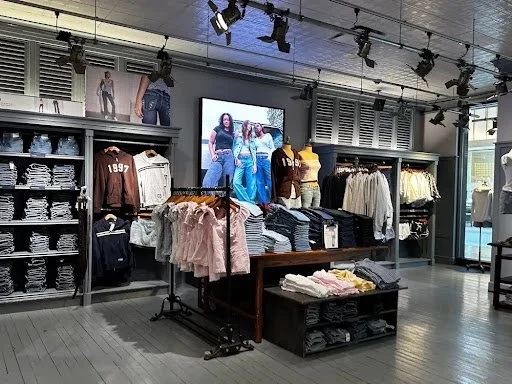Exclusive: How Fast Fashion Is Wrecking Your Closet–And The Environment
The Fashion Stock Market here, your one and only source into the hottest style trends and fashion events. Do you want to know what’s been bugging me lately? Polyester. I used to trust that when I went to online shop for dresses at, say, House of CB or REVOLVE, I wouldn’t be slapped by the phrase, “100% Polyester” on every single clothing tag. For the longest time, I didn’t even question it; tags with material details on them have been getting smaller and smaller as it is, and I never even understood what polyester is; but I’ve come to a point where I can no longer deny the horrors of the synthetic fibers epidemic. In case you’re oblivious to the ugly truth behind fashion production, I’ve compiled all you need to know about the polyester issue, and how fast fashion is destroying our clothes and filling our landfills. But let me not get ahead of myself; this story begins with the Hollister Y2K collection.
Bows fell just as quickly as they rose, becoming over-saturated in the blink of an eye.
Photo: Walmart
A few weeks ago, as I was scrolling on TikTok, I came across a page that analyzed the release of Hollister’s retro collection. Intended to be a nod to the company’s early 2000s styles, featuring babydoll tops and low-rise shorts, netizens felt the drop fell short of the original. Considering the collection was inspired by the vintage Hollister resurgence on reseller sites, many shoppers were disappointed by the stark differences between the old and new. Apart from the clothes themselves, Hollister fans noted the difference in quality and were shocked; while the brand used to prioritize better materials like cotton, most pieces were made from a polyester blend. And to many ecstatic vintage lovers’ dismay, the detailing and overall feel of the clothes reflected the drop’s cheap materials. Despite the poor quality, prices did not reflect what was being sold. What costs a few bucks to produce is being sold at about five times the price. It’s clear why millennials and even Gen Z shoppers have skipped out on the collection, despite the buzz created before its release. As I did more digging, I realized this is not a problem created by the Hollister Y2K drop; cheaper materials are being sold for higher prices everywhere, from your favorite mall chain to designer labels. How did we get here, and oh my gosh, how do we get out?
Quality has decreased because companies have turned to cheap, synthetic fibers like polyester, nylon, and acrylic to produce clothing.
Photo: italianartisan
The answer: fast fashion. You may have heard of this term in relation to giants like Temu and Shein, but fast fashion affects all retailers (even the really, really fancy ones). Long story short, with fashion companies offshoring production to Asia in the 1970s, they were able to keep labor costs low and turn a huge profit. To further this profit and ensure quick distribution of product, they turned to cheaper and accessible materials. By taking advantage of workers and worsening the clothes’ quality, these companies were able to take shortcuts to ensure swift and simple success. Naturally, over the years, everyone else followed suit, with the average consumer being none-the-wiser. At this point, the evils of fast fashion know no bounds: prison labor, environmental harms, and contributing to consumerism are just the tip of the iceberg. Everyone is affected by this toxic system, so everyone should know what to look out for. With nearly 80 percent of young consumers claiming they’d pay for ethical, higher-quality clothes, it seems this generation is talking the talk. But to make change, we have to walk the catwalk.
At this point, the evils of fast fashion know no bounds: prison labor, environmental harms, and contributing to consumerism are just the tip of the iceberg.
Photo: Rio Lecatompessy/Unsplash
Quality has decreased over time because companies have turned to cheap, synthetic fibers like polyester, nylon, and acrylic to produce clothing. After some digging, I discovered that 52% of all fiber production is polyester, aka plastic. While this isn’t entirely new to fast fashion and not necessarily a bad thing, it’s no wonder why most clothes feel cheaper, often ending up in landfills after a couple of wears. Despite its durability, plastic simply can’t compete with cotton, silk, linen, wool, and leather. The site Earth Day reported that in the next ten years, an estimated 92 million tons of polyester are expected to be produced. If that happens, our landfills will be overflowing with clothes while companies continue to rob us blind, polluting the air with fossil fuels in the process of creating this material. It’s no wonder why the average household in the 1960s bought 25 garments of clothes, compared to today’s 68 garments. We are buying clothes made to be thrown away and rebought, adding further stress on our wallets. What a waste, in more ways than one!
Apart from the clothes themselves, Hollister fans noted the difference in quality and were shocked; while the brand used to prioritize better materials like cotton, most pieces were made from a polyester blend.
Photo: Amanda Krause/Business Insider
Aside from the actual production of clothing, fast fashion has had its impact on the creative side of the industry, in particular trend cycles. Fast fashion’s speedy production causes trends to come and go at a rapid speed. In the past, fashion changed with the seasons, with trends lasting for at least a few months at a time. Today, trends cycle in and out like the tide, with each week offering something new. Social media has helped push trends along faster and faster, but fast fashion is mainly to blame. Take bows, for example: what started off as a cute addition to shirts, bags, and even jeans quickly spiraled into virality, spreading faster than COVID. Bows fell just as quickly as they rose, becoming over-saturated in the blink of an eye. People are now sick of bows and opting for other cute patterns, like polka dots, stripes, or even sardines. With trends coming and going so quickly, companies overproduce products to try and keep up; but the nature of fast fashion means that they never will, and the harmful cycle will just continue.
Intended to be a nod to the company’s early 2000s styles, featuring babydoll tops and low-rise shorts, netizens felt the drop fell short of the original in more ways than one.
Photo: Hollister
Despite what many people may try to get you to believe, the problem does not solely lie on the shoulders of the consumer. The power to beat fast fashion is ultimately in the hands of the fashion companies that use cheap materials and harm workers to pump out products. There is something we can do as shoppers and lovers of fashion, though. For starters, we can try not to support fast fashion giants, and instead thrift or buy clothes made from sustainable materials. There’s nothing wrong with having a little fun and giving in to the indescribable allure of the next trend, but maybe don’t buy those neon green sequin microshorts from Edikted that will only be worn once before you get sick of them. Whenever you buy a new piece, ask yourself if you can see yourself wearing it in various different outfits, a few years down the line. If your gut is telling you no, then maybe you don’t need that specific item of clothing. I know, it sucks to admit, but someone has to tell you the cold hard truth that consumerism plays a big role in fast fashion. Stay strong, readers!
My take? Our economy puts us in such a bad spot spending wise, it’s no surprise fast fashion retailers are so popular. Everyone wants to be stylish on a budget, but be honest with yourself: if you are a true lover of fashion, would you buy something that directly contributes to its downfall? I urge you, in the name of fashion, put the credit card down, and open up Maps to find the nearest thrift store near you. As astute fashion investors, we must keep our spending habits in check, because love of shopping does not equal love of fashion. Now go out into the world and spread the good news, Fashion Stock Market disciples. And whatever you do, do not spend $300 on a 100% polyester dress. Until next time.
XOXO, The Fashion Stock Market
Cover Photo: The Donkey Sanctuary/Flickr
Editor: Annaliese Persaud




